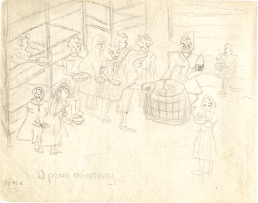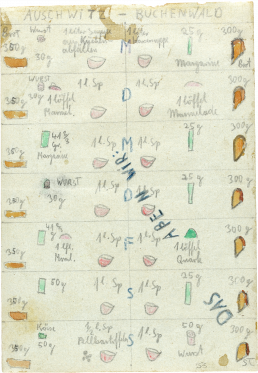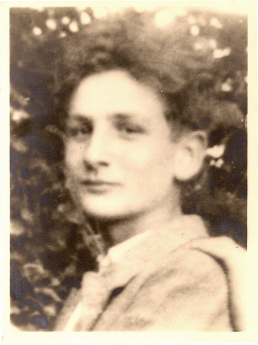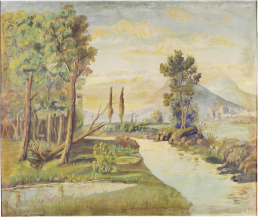All contact with the camp SS was marked by violence. Hunger was a constant companion of the children and adolescents in the concentration camp. The catastrophic hygienic conditions led to an accumulation of diseases from which there was hardly any protection.
The children and adolescents lived in constant fear of death. They watched many people, including friends and relatives, die. Not only were they backward in their physical development due to hunger and diseases, they were also robbed of their childhood.
Gert Silberbard in an interview with David P. Boder in Geneva, August 27, 1946.
At the age of 16, Gert Silberbard was deported from Auschwitz to Buchenwald. In 1946, he vividly recalled being deprived of food and water after arriving at the Little Camp.
(„Voices of the Holocaust“, Illinois Institute of Technology)
MEALS FOR AN ENTIRE WORKDAY
8 a.m. - First breakfast
1 glass of hot milk with butter and honeyRoll with butter and hamRoll with honeyRoll with jam or with something else
11 o'clock - Second breakfast
Pancakes with ham and scrambled eggs, rolled in breadcrumbs and fried in butterNoodles au gratin with eggs, honeyand melted butter with rice frittersNoodles with apples, butter and rolls
2 o'clock - Lunch
Clear soup (barley soup) made of chicken broth and breadcrumbsor with fat dumplingsStuffed beef with potatoes and paprika sauceItalian pasta casserole with smoked sausage and tomatoesPierogi with liverDessert of semolina pudding with vanilla sauceFruit dessert, pudding from millet groats with jamA glass of eggnog
17 o'clock - Supper
Asparagus in tomato sauceCauliflower frittersSpätzle with butter and rollsStuffed peppers with tomato saucePotato pancakes with cream
The menu is unfinished. THERE’S AN ALARM AGAIN!
Dream menu for a whole working day by Maria Brzęcka, December 1944.
Maria Brzęcka, then 14 years old, put together her dream menu for when she was freed from the Meuselwitz labor camp. However, she could not remember the taste of most of the dishes and asked the women in her quarters to describe them to her. She couldn’t finish her list because of an air raid alert.
(Als Mädchen im KZ Meuselwitz. Erinnerungen von Maria Brzęcka-Kosk, Dresden 2016)
"This is what we ate." Drawing by Thomas Geve, 1945.
In his drawing, the 16-year-old compared the food rations in Auschwitz and Buchenwald, where he was liberated on 11 April 1945.
(Yad Vashem)
"So we handled heavy, toxic raw materials, picked everything up without protective gloves, no protective masks or aprons were required for us, we breathed in all the poisons and stood up to our knees in saltpeter. The locals called us "lemons" because our skin was so discolored."
Éva Pusztai-Fahidi recalls the deadly working conditions, 2011.
Éva Fahidi, who was deported from Hungary as a teenager, was a forced laborer in the Münchmühle subcamp. The working conditions in the munitions factory were murderous, and the prisoners could not protect themselves from hazardous substances because there was no protective clothing for them.
(Éva Fahidi, The Soul of Things, University of Toronto Press, 2020)
Plaster fresco from a barracks in the Ellrich-Juliushütte subcamp, made by Tanguy Tolila-Croissant in the fall of 1944.
Tanguy Tolila-Croissant was born in Paris on 16 October 1925. He began studying art at the École Nationale Supérieure des Beaux Arts in Paris in 1942. In June 1944, he was arrested for resisting the German occupiers and deported to the Buchenwald Concentration Camp in August, then to Ellrich-Juliushütte. There, he frescoed the walls in his block. Many similar pictures created by him have survived from the time before his arrest – with one difference: never is a dead tree to be seen. Tolila-Croissant died on 30 December 1944, at the age of 19.
(German Historical Museum)



